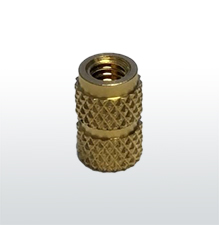Inserts in Thermoset Molding
Molded thermoset composites provide end products and assemblies with excellent material performance in dimensional stability, heat resistance, and electrical properties. With it’s dimensional stability and stiffness to molded parts, manufacturers generally utilize inserts as fastening mechanisms to mate multiple parts in an assembly. Whereas thermoplastics can be designed with locking mechanisms and snap fits, thermosets stiffness do not allow for these details to be designed into a part and require a secondary fastening option. Threaded inserts are one of the most common fastening mechanisms used in thermoset assemblies due to their ability to be molded into the part or tapped in a secondary operation. Depending on the part and assembly requirements, each option has its own benefits and advantages. Below are two main types of inserts used within molded thermoset parts.
Molded-In Inserts
Molding in inserts within the molding cycle is an economical way to implement inserts as there is no secondary step required after the parts are molded. Molded in inserts will require an operator or end of arm tooling to install the inserts prior to molding each shot, however the resulting molded parts feature inserts
that are bonded into the part, creating a stable fastener to assembly multiple parts of an assembly. The bonding is created during the molding cycle as the resin material encapsulates the outside of the insert, which are usually knurled, holding the insert in the correct position into the part.
Post-Tapped Inserts
Post-tapping inserts is a secondary operation performed after parts are already molded where threaded inserts are mechanically driven into a molded part. Self-tapping inserts are an excellent option for molded parts that require a stable consistent cycle time that cannot be affected by manually loading molded in inserts. Loading molded-in inserts at the press also keeps the mold open, which can cool the mold from normal processing temperatures, potentially resulting in more scrapped or rejected parts.






Comments are closed